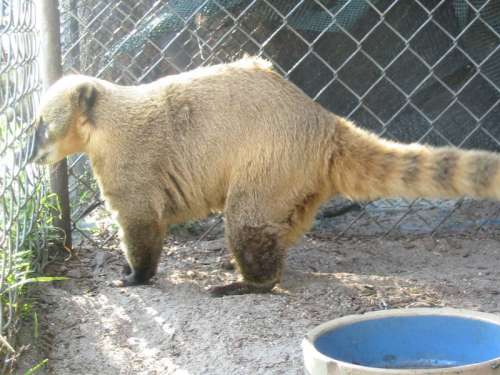Birds
Parrots
Blue Front Amazon
Mammals
Cats
Cougar
Leopard
Lion
Lynx
Tiger
Large Mammals
American Black Bear
Camel
Medium Mammals
Coatimundi
Raccoon
Ring-tailed Lemur
Two-Toed Sloth
White Nosed Coati
Primates
Vervet
Reptiles
Crocodile Family
American Alligator
Caiman
Lizards
Bearded Dragon
Blue-Tongued Skink
Crocodile Monitor
Leopard Gecko
Snakes
Non-Venomous
Ball Python (Royal Python)
Venomous
Copperhead
Eastern Diamond-back Rattlesnake
Northern Coral Snake
Pygmy Rattlesnake
Turtles
Tortoises
Gopher Tortoise
|
 |
Coatimundi
Nasua nasua
Kingdom: | Animalia | Phylum: | Chordata | Class: | Mammalia | Order: | Omnivora | Family: | Procyonidae | Genus: | Nasua | Species: | nasua |
|
Description
Coati upper parts are dark brown, gray, or dark or brightly rust colored. The underparts are white. The head is narrow with the nose slightly turned upward and elongated, and is very flexible, allowing coaties to search out food under leaf litter and overturned debris. The muzzle is brown with pale spots above, below, and behind the eye.
Click
Here to See Coatimundi Pictures
Average Statistics
Length | 2.5 to 3.5 ft |  | Weight | 6 to 13 lbs | Geographic Range | Tropical regions of South America, from Columbia and Venezuela to Uruguay, northern parts of Argentina, and into Ecuador. |
DietPrimarily omnivorous, coatis usually seek out fruits and invertebrates. Coatis eat palms, eggs, larval beetles, scorpions, centipedes, spiders, ants, termites, lizards, small mammals, rodents, and carrion when it is available. They infrequently take chickens. OffspringFemales give birth to 3-7 youngsters after a gestation of 75 days. Young open their eyes at 10 days old, can stand at 20 days, can climb trees at 30 days and can eat solid foods at 4 months. SoundsCoatimundis are very vocal, and make high-pitched squeaks. Relationship with HumansCoaties are not endangered and serve as pest control by eating rodents. |

